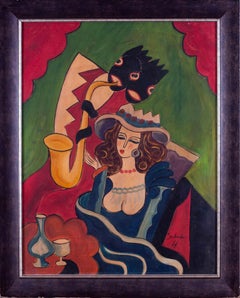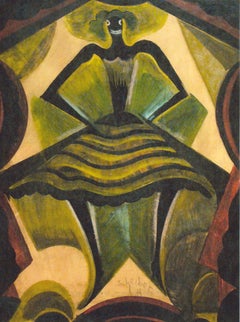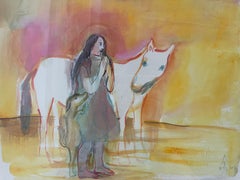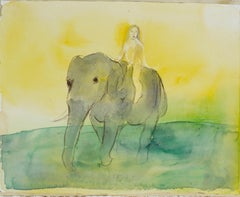Hugó Scheiber Paintings
to
6
1
2
7
3
1
3
Overall Height
to
Overall Width
to
2
2
6
5
3
2
2
1
1
1
1
7
1
1
2
15
919
650
639
610
5
3
3
3
3
Artist: Hugó Scheiber
Rare Modernist Hungarian Rabbi Pastel Drawing Gouache Painting Judaica Art Deco
By Hugó Scheiber
Located in Surfside, FL
Rabbi in the synagogue at prayer wearing tallit and tefillin.
Hugó Scheiber (born 29 September 1873 in Budapest – died there 7 March 1950) was a Hungarian modernist painter.
Hugo Scheiber was brought from Budapest to Vienna at the age of eight where his father worked as a sign painter for the Prater Theater. At fifteen, he returned with his family to Budapest and began working during the day to help support them and attending painting classes at the School of Design in the evening, where Henrik Papp was one of his teachers. He completed his studies in 1900. His work was at first in a post-Impressionistic style but from 1910 onward showed his increasing interest in German Expressionism and Futurism. This made it of little interest to the conservative Hungarian art establishment.
However, in 1915 he met the great Italian avant-gardist Filippo Tommaso Marinetti and the two painters became close friends. Marinetti invited him to join the Futurist Movement. The uniquely modernist style that he developed was, however, closer to German Expressionism than to Futurism and eventually drifted toward an international art deco manner similar to Erté's. In 1919, he and his friend Béla Kádar held an exhibition at the Hevesy Salon in Vienna. It was a great success and at last caused the Budapest Art Museum to acquire some of Scheiber's drawings. Encouraged, Scheiber came back to live in Vienna in 1920.
A turning point in Scheiber's career came a year later, when Herwarth Walden, founder of Germany's leading avant-garde periodical, Der Sturm, and of the Sturm Gallery in Berlin, became interested in Scheiber's work. Scheiber moved to Berlin in 1922, and his paintings soon appeared regularly in Walden's magazine and elsewhere. Exhibitions of his work followed in London, Rome, La Paz, and New York.
Scheiber's move to Germany coincided with a significant exodus of Hungarian artists to Berlin, including Laszlo Moholy-Nagy and Sandor Bortnyik. There had been a major split in ideology among the Hungarian avant-garde. The Constructivist and leader of the Hungarian avantgarde, Lajos Kassák (painted by Hugó Scheiber in 1930) believed that art should relate to all the needs of contemporary humankind. Thus he refused to compromise the purity of his style to reflect the demands of either the ruling class or socialists and communists. The other camp believed that an artist should be a figurehead for social and political change.
The fall out and factions that resulted from this politicisation resulted in most of the Hungarian avant gardists leaving Vienna for Berlin. Hungarian émigrés made up one of the largest minority groups in the German capital and the influx of their painters had a significant effect on Hungarian and international art. Another turning point of Scheiber's career came in 1926, with the New York exhibition of the Société Anonyme, organized by Katherine Dreier. Scheiber and other important avant garde artists from more than twenty-three countries were represented. In 1933, Scheiber was invited by Marinetti to participate in the great meeting of the Futurists held in Rome in late April 1933, Mostra Nazionale d’Arte Futurista where he was received with great enthusiasm. Gradually, the Hungarian artists began to return home, particularly with the rise of Nazism in Germany. Kádar went back from Berlin in about 1932 and Scheiber followed in 1934.
He was then at the peak of his powers and had a special flair in depicting café and cabaret life in vivid colors, sturdily abstracted forms and spontaneous brush strokes. Scheiber depicted cosmopolitan modern life using stylized shapes and expressive colors. His preferred subjects were cabaret and street scenes, jazz musicians, flappers, and a series of self-portraits (usually with a cigar). his principal media being gouache and oil. He was a member of the prestigious New Society of Artists (KUT—Képzőművészek Új Társasága)and seems to have weathered Hungary's post–World War II transition to state-communism without difficulty. He continued to be well regarded, eventually even receiving the posthumous honor of having one of his images used for a Russian Soviet postage stamp (see image above). Hugó Scheiber died in Budapest in 1950.
Paintings by Hugó Scheiber form part of permanent museum collections in Budapest (Hungarian National Museum), Pecs (Jannus Pannonius Museum), Vienna, New York, Bern and elsewhere. His work has also been shown in many important exhibitions, including:
"The Nell Walden Collection," Kunsthaus Zürich (1945)
"Collection of the Société Anonyme," Yale University Art Gallery, New Haven, Connecticut (1950)
"Hugó Scheiber: A Commemorative Exhibition," Hungarian National Museum, Budapest (1964)
"Ungarische Avantgarde," Galleria del Levante, Munich (1971)
"Paris-Berlin 1900-1930," Centre Georges Pompidou, Paris (1978)
"L’Art en Hongrie, 1905-1920," Musée d’Art et l’Industrie, Saint-Etienne (1980)
"Ungarische Avantgarde in der Weimarer Republik," Marburg (1986)
"Modernizmus," Eresz & Maklary Gallery, Budapest (2006)
"Hugó Scheiber & Béla Kádár," Galerie le Minotaure, Paris and Tel Aviv (2007)
Hugó Scheiber's paintings continue to be regularly sold at Sotheby's, Christie's, Gillen's Arts (London), Papillon Gallery (Los Angeles) and other auction houses.
He was included in the exhibition The Art Of Modern Hungary 1931 and other exhibitions along with Vilmos Novak Aba, Count Julius Batthyany, Pal Bor, Bela Buky, Denes Csanky, Istvan Csok, Bela Czobel, Peter Di Gabor, Bela Ivanyi Grunwald, Baron Ferenc Hatvany, Lipot Herman, Odon Marffy, C. Pal Molnar...
Category
Early 20th Century Modern Hugó Scheiber Paintings
Materials
Paper, Charcoal, Pastel, Watercolor, Gouache
Early 20th Century oil painting 'Le Cafe Concert' by Hugo Scheiber, reds
By Hugó Scheiber
Located in Petworth, West Sussex
A really fun and lively modernist painting of jazz cafe culture in the early 20th Century by Hungarian artist Hugo Scheiber.
Hugo Scheiber (Hungarian 1858 – 1950) 1873-1950
Le café ...
Category
20th Century Modern Hugó Scheiber Paintings
Materials
Oil
"Jazz Musician" Oil Painting 1930 by Hugó Scheiber
By Hugó Scheiber
Located in Berlin, DE
Oil on wood, 1930. Signed lower right. Framed. Height 31.10 in ( 79 cm ), Width 25.19 in ( 64 cm )
The Hungarian artist Hugó Scheiber lived 1922-1934 in Berlin, that's where he pai...
Category
1930s Cubist Hugó Scheiber Paintings
Materials
Oil, Wood Panel
At the Winery - Hungarian Art
By Hugó Scheiber
Located in London, GB
This original painting is hand signed by the artist "Scheiber H" in the lower left corner,
and dated "1940" below the signature.
Exhibited: Hugo Scheiber - Bela Kadar, Galerie Le Mi...
Category
1940s Hugó Scheiber Paintings
Materials
Tempera, Gouache
Self Portrait
By Hugó Scheiber
Located in London, GB
HUGO SCHEIBER 1873-1950
1873 - Budapest - 1950 (Hungarian)
Title: Self Portrait
Technique: Original Signed Pastel Drawing on Paper
Size: 37.7 x 30 cm. / 14.8 x 11.8 in.
Additiona...
Category
1940s Futurist Hugó Scheiber Paintings
Materials
Pastel
Hugó Scheiber Theater Scene with a Dancer, Gouache ca. 1920
By Hugó Scheiber
Located in Berlin, DE
Gouache on paper, 1920's by Hugò Scheiber ( 1873-1950 ) Hungary. Signed with pencil lower central: Scheiber H.
Framed under glass. Height: 25.98 in ( 66 cm ), Width: 19.69 in ( 50 c...
Category
1920s Expressionist Hugó Scheiber Paintings
Materials
Gouache, Paper
Hugó Scheiber Pastel "Sailing", about 1930
By Hugó Scheiber
Located in Berlin, DE
Pastel and carbon pencil on cardboard, ca. 1930 by Hugo Scheiber. Signed lower left: Scheiber H.
Dimensions: 14.96 x 12.99 in ( 38 x 33 cm ), Framed: 19.69 x 15.75 in ( 50 x 40 cm )
Hugo Scheiber born 1873 Budapest - he died 1953...
Category
Early 20th Century Expressionist Hugó Scheiber Paintings
Materials
Carbon Pencil, Pastel, Cardboard
Related Items
Expressionist Figurative water color painting- Series The Horse Whisper No.2-25
Located in Beijing, CN
Expressionist Figurative water color painting by Zhang Chunyang
Series The Horse Whisper No.2-25
Dimension: 29 x 36 cm
Material: Gouache, Watercolor on Paper
Date: 2013
Artist B...
Category
2010s Expressionist Hugó Scheiber Paintings
Materials
Watercolor, Gouache, Handmade Paper
Zhang ChunyangExpressionist Figurative water color painting- Series The Horse Whisper No.2-25 , 2013
Free Shipping
H 11.42 in W 14.18 in
Expressionist Figurative water color painting- Luckiness
Located in Beijing, CN
Expressionist Figurative water color painting by Zhang Chunyang
Title: Luckiness
Dimension: 29 x 36 cm
Material: Gouache, Watercolor on Paper
D...
Category
2010s Expressionist Hugó Scheiber Paintings
Materials
Watercolor, Gouache, Handmade Paper
Free Shipping
H 11.42 in W 14.18 in
Figurative landscape oil painting- Sunny Afternoon
Located in Beijing, CN
Dai Xiangwen was born in Hunan in 1991 and graduated from the Academy of Fine Arts of Jianghan University,
He is a member of China Artists Association, China Designers Association, a painter of Li Keran...
Category
2010s Modern Hugó Scheiber Paintings
Materials
Canvas, Oil
Free Shipping
H 23.63 in W 31.5 in
Lee Hurst (3/4 Figure, Hands Together), Mixed media on Pergamenata parchment
By Howard Tangye
Located in London, GB
Howard Tangye (b.1948, Australia) has been an influential force in fashion for decades. Lecturing at London’s Central Saint Martins for 35 years, including 16 years as head of BA Wom...
Category
2010s Contemporary Hugó Scheiber Paintings
Materials
Paint, Paper, Parchment Paper, Charcoal, Crayon, Oil Crayon, Oil Pastel,...
Poseidon - Ink and Tempera on Paper by Lucie Navier - 1933
By Lucie Navier
Located in Roma, IT
Poseidon is an original painting realized by Lucie Navier in 1933.
Original Ink and tempera painting on paper.
Dated on the lower right corner (23-6-2033).
Fair conditions except...
Category
1930s Modern Hugó Scheiber Paintings
Materials
Tempera, Watercolor, Ink
H 13 in W 9.45 in D 0.04 in
Spirit
By William Y. Cooper
Located in Buffalo, NY
"Spirit" a bold and thoughtful cubist oil on canvas was painted in December of 2001 by African American artist William (Bill) Cooper.
William Y. Cooper was a writer, painter, muralist, illustrator, and art teacher. He moved to Western New York in 1954 from Birmingham, Alabama, to pursue work, and Buffalo has been his home ever since. In 1975, he received his Bachelor of Fine Arts degree from the University at Buffalo; he was also a state certified art teacher.
Cooper woked primarily in oils and acrylics, but also creates drawings on paper. He has painted several commissioned murals and has had more than fifteen one-man shows in Western New York and Ghana, West Africa, and has participated in more than twenty-five group exhibitions since he began his professional career in 1969.
His paintings and drawings address both his African heritage and his experience as an American through symbolism and metaphor. He observes, “I am an Afrocentric artist. My worldview is rooted in an African frame of reference and a deep, abiding sense of the creator from whence I draw my inspiration, strength, and a sense of who I am. The use of symbols allows me to explore literal ideas.”
Among Cooper’s published works are two children’s books, 77 Jackson Street, Rear and Nakai and the Red Shoes, and a novel for adults, The Mopane Tree.
Cooper founded the Afrocentric Artists’ Collective and ran the organization from 1979 to 1981. In 2013 he was designated a “Living Legacy” artist by the Burchfield Penney Arts Center, the latest in a series of honors which has also included awards from the Arts Council of Buffalo & Erie County, the New York State Council on the Arts, and Alpha Kappa Alpha...
Category
21st Century and Contemporary Cubist Hugó Scheiber Paintings
Materials
Canvas, Oil
Interior
By Alfred McNamara
Located in Los Angeles, CA
ALFRED MCNAMARA
"INTERIOR "
OIL ON PANEL, SIGNED
TITLED
AMERICAN, DATED 1978
30 X 36 INCHES
Alfred McNamara
(1911 - 1994)
Alfred McNamara was born in Tompkinsville, Staten Island and lived most of his life in Staten Island.
He was heavily influenced by John Sloane...
Category
1970s Cubist Hugó Scheiber Paintings
Materials
Oil, Panel
At the Beach - Tempera and Watercolor by Aldo Riso - 1970s
By Aldo Riso
Located in Roma, IT
At the beach is an artwork realized by Aldo Riso.
Mixed colored tempera and watercolor painting.
Titled on lower left.
Frame included: 70.5 x 91.5 cm
This beautiful mixed media...
Category
1970s Contemporary Hugó Scheiber Paintings
Materials
Watercolor, Tempera
H 24.02 in W 31.89 in D 1.19 in
'Portrait of Future Man', German School
Located in London, GB
'Portrait of Future Man', oil on board, Berlin School, (circa 1960s). A thoroughly modern portrait clearly in the style of Italian Futurist, Fortunato Depero (1892-1960). Futurism co...
Category
1960s Futurist Hugó Scheiber Paintings
Materials
Oil, Board
Sacré-Coeur Montmartre at Willette Square Paris
By Lucien Génin
Located in London, GB
'Sacré-Coeur, Montmartre at Willette Square, Paris', gouache on art paper (circa 1930s), by Lucien Génin. Created by the Director of Public Ways and Promenades under Napoleon III, Sq...
Category
1930s Expressionist Hugó Scheiber Paintings
Materials
Paper, Gouache
Gouache Watercolor Painting, Nantucket Harbor Boats American Deaf Modernist Art
By Robert Freiman
Located in Surfside, FL
Abstract harbor scene with boats, in bold, vivid colors on heavy mould made paper.
Hand signed and dated, 1980
22 X 30 not frame
Robert Freiman, deaf from birth, was born in March 1917 in New York City. He attended an oral program near his home and later transferred to the Lexington School for the Deaf when he was six. Early in his childhood, his love for drawing, painting and studying became apparent, and as an adult, he continued his studies in New York at the National Academy of Design, Pratt Institute, the Art Students League and the Parsons School of Design. In Paris, France he studied at the Ecole des Beaux Arts. Bob Freiman was especially focused on painting portraits and figures in motion in various mediums, especially the mixed-media combination of watercolor, acrylic and pen. Among his subjects were acrobats, ballet dancers, cyclists and other athletes. He as well focused on abstracts for a time, discovering new media in his works with quick brushwork and expressive movements.
In the latter part of his career, his style became abstract and surreal with images of metaphysical landscapes with architectural elements such as arches, towers, pyramids and castles floating in the air. The famed art critic Pierre Rouve wrote: “It is therefore refreshing to see them revitalized by the colourist wealth and virile handwriting of Robert Freiman, probably the best American water-colorist since John Marin. He worked in Provincetown and Nantucket and regularly exhibited there. He showed at Doll & Richards gallery of Boston alongside John Chetcuti, Lloyd Goodrich, Tod Lindenmuth, William Meyerowitz, Dwight Shepler, Elizabeth O'Neill Verner, Stanley Woodward, Andrew Wyeth, and others. His work bears the influence of the mid century school of Paris in particular Jean Carzou. He was a regular exhibitor at the Sidewalk Art...
Category
1980s Expressionist Hugó Scheiber Paintings
Materials
Watercolor, Gouache, Archival Paper
Costume - Original Painting by Alkis Matheos - Mid-20th Century
By Alkis Matheos
Located in Roma, IT
Costume is an original painting artwork in mixed media, tempera and watercolor on paper realized by the Greek-French artist Alkis Matheos.
Good conditio...
Category
20th Century Modern Hugó Scheiber Paintings
Materials
Tempera, Watercolor, Mixed Media
H 12.6 in W 9.85 in D 0.04 in
Previously Available Items
Rare Modernist Hungarian Rabbi Pastel Drawing Gouache Painting Judaica Art Deco
By Hugó Scheiber
Located in Surfside, FL
Rabbi in the synagogue at prayer wearing tallit and tefillin.
Hugó Scheiber (born 29 September 1873 in Budapest – died there 7 March 1950) was a Hungarian modernist painter.
Hugo Scheiber was brought from Budapest to Vienna at the age of eight where his father worked as a sign painter for the Prater Theater. At fifteen, he returned with his family to Budapest and began working during the day to help support them and attending painting classes at the School of Design in the evening, where Henrik Papp was one of his teachers. He completed his studies in 1900. His work was at first in a post-Impressionistic style but from 1910 onward showed his increasing interest in German Expressionism and Futurism. This made it of little interest to the conservative Hungarian art establishment.
However, in 1915 he met the great Italian avant-gardist Filippo Tommaso Marinetti and the two painters became close friends. Marinetti invited him to join the Futurist Movement. The uniquely modernist style that he developed was, however, closer to German Expressionism than to Futurism and eventually drifted toward an international art deco manner similar to Erté's. In 1919, he and his friend Béla Kádar held an exhibition at the Hevesy Salon in Vienna. It was a great success and at last caused the Budapest Art Museum to acquire some of Scheiber's drawings. Encouraged, Scheiber came back to live in Vienna in 1920.
A turning point in Scheiber's career came a year later, when Herwarth Walden, founder of Germany's leading avant-garde periodical, Der Sturm, and of the Sturm Gallery in Berlin, became interested in Scheiber's work. Scheiber moved to Berlin in 1922, and his paintings soon appeared regularly in Walden's magazine and elsewhere. Exhibitions of his work followed in London, Rome, La Paz, and New York.
Scheiber's move to Germany coincided with a significant exodus of Hungarian artists to Berlin, including Laszlo Moholy-Nagy and Sandor Bortnyik. There had been a major split in ideology among the Hungarian avant-garde. The Constructivist and leader of the Hungarian avantgarde, Lajos Kassák (painted by Hugó Scheiber in 1930) believed that art should relate to all the needs of contemporary humankind. Thus he refused to compromise the purity of his style to reflect the demands of either the ruling class or socialists and communists. The other camp believed that an artist should be a figurehead for social and political change.
The fall out and factions that resulted from this politicisation resulted in most of the Hungarian avant gardists leaving Vienna for Berlin. Hungarian émigrés made up one of the largest minority groups in the German capital and the influx of their painters had a significant effect on Hungarian and international art. Another turning point of Scheiber's career came in 1926, with the New York exhibition of the Société Anonyme, organized by Katherine Dreier. Scheiber and other important avant garde artists from more than twenty-three countries were represented. In 1933, Scheiber was invited by Marinetti to participate in the great meeting of the Futurists held in Rome in late April 1933, Mostra Nazionale d’Arte Futurista where he was received with great enthusiasm. Gradually, the Hungarian artists began to return home, particularly with the rise of Nazism in Germany. Kádar went back from Berlin in about 1932 and Scheiber followed in 1934.
He was then at the peak of his powers and had a special flair in depicting café and cabaret life in vivid colors, sturdily abstracted forms and spontaneous brush strokes. Scheiber depicted cosmopolitan modern life using stylized shapes and expressive colors. His preferred subjects were cabaret and street scenes, jazz musicians, flappers, and a series of self-portraits (usually with a cigar). his principal media being gouache and oil. He was a member of the prestigious New Society of Artists (KUT—Képzőművészek Új Társasága)and seems to have weathered Hungary's post–World War II transition to state-communism without difficulty. He continued to be well regarded, eventually even receiving the posthumous honor of having one of his images used for a Russian Soviet postage stamp (see image above). Hugó Scheiber died in Budapest in 1950.
Paintings by Hugó Scheiber form part of permanent museum collections in Budapest (Hungarian National Museum), Pecs (Jannus Pannonius Museum), Vienna, New York, Bern and elsewhere. His work has also been shown in many important exhibitions, including:
"The Nell Walden Collection," Kunsthaus Zürich (1945)
"Collection of the Société Anonyme," Yale University Art Gallery, New Haven, Connecticut (1950)
"Hugó Scheiber: A Commemorative Exhibition," Hungarian National Museum, Budapest (1964)
"Ungarische Avantgarde," Galleria del Levante, Munich (1971)
"Paris-Berlin 1900-1930," Centre Georges Pompidou, Paris (1978)
"L’Art en Hongrie, 1905-1920," Musée d’Art et l’Industrie, Saint-Etienne (1980)
"Ungarische Avantgarde in der Weimarer Republik," Marburg (1986)
"Modernizmus," Eresz & Maklary Gallery, Budapest (2006)
"Hugó Scheiber & Béla Kádár," Galerie le Minotaure, Paris and Tel Aviv (2007)
Hugó Scheiber's paintings continue to be regularly sold at Sotheby's, Christie's, Gillen's Arts (London), Papillon Gallery (Los Angeles) and other auction houses.
He was included in the exhibition The Art Of Modern Hungary 1931 and other exhibitions along with Vilmos Novak Aba, Count Julius Batthyany, Pal Bor, Bela Buky, Denes Csanky, Istvan Csok, Bela Czobel, Peter Di Gabor, Bela Ivanyi Grunwald, Baron Ferenc Hatvany, Lipot Herman, Odon Marffy, C. Pal Molnar...
Category
Early 20th Century Modern Hugó Scheiber Paintings
Materials
Charcoal, Gouache, Pastel, Paper, Watercolor
Hugó Scheiber paintings for sale on 1stDibs.
Find a wide variety of authentic Hugó Scheiber paintings available for sale on 1stDibs. You can also browse by medium to find art by Hugó Scheiber in paint, crayon, gouache and more. Much of the original work by this artist or collective was created during the 20th century and is mostly associated with the Expressionist style. Not every interior allows for large Hugó Scheiber paintings, so small editions measuring 12 inches across are available. Customers who are interested in this artist might also find the work of Béla Czóbel, Jack Levine, and Franz Bergmann. Hugó Scheiber paintings prices can differ depending upon medium, time period and other attributes. On 1stDibs, the price for these items starts at $5,500 and tops out at $28,076, while the average work can sell for $9,929.








